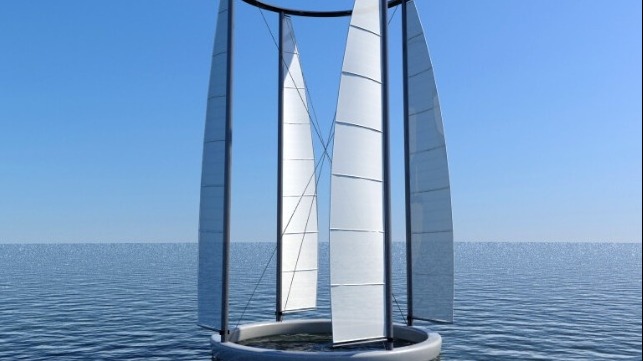Revolutionary Design for Floating Offshore Wind Turbine

A startup U.S. company is promoting a radically different design for offshore wind turbines it says are less expensive and faster to build with a concept better suited to floating offshore applications. Unlike traditional wind turbines, American Offshore Energy has patented a design that has no central shaft and instead moves the bearings and electrical generation to the perimeter with a lower center of gravity that is easier to float than horizontal axis wind turbines (HAWT).
The company asserts that currently turbines that have been successful on land are being put on floating structures because they are the dominant wind turbine technology, not because someone thought rationally about how best to make a floating wind turbine. They see a strong opportunity to revolutionize floating wind turbines noting that the key technologies enabling the opportunity are water-based hydrostatic perimeter support bearings, direct drive HVDC generation at the perimeter, and tension and compression design principles.
Drawing on its experience as sailboat racers, they employed concepts from Americas Cup sailboat racing to build a lightweight but powerful aerodynamic rotor that may be "trimmed" to conditions. The design for the "American Turbine," is the first wind turbine that has no center shaft. The bearings and electrical generation move to the perimeter where there are high surface speeds even at low RPMs, eliminating the need for rolling bearings, gearboxes, and oil.
According to the company, the big idea is that to make a floating wind turbine, it makes more sense to reach up into the wind with a lightweight structure, like a cross between sailboat masts and bicycle wheels, keeping the heavier bearings and generator near sea level.
Because of the fluid film bearing technology, axial and radial loads are separated. This means that the axial bearings, carrying the weight of the rotating assembly, may push down or pull up on a float, but cannot introduce a moment load. Because the floats are loaded in only tension or compression, they may be made from fiberglass at a tenth of the weight per MW of the oil derrick-like floats required for HAWT designs.
The note that HAWT have the loads and masses at the top of a long pole, they are cantilevered, so a 50-ton force at the top of a 100-meter tower puts more than 500 tons of force into a floating base that is holding the bottom 10 meters. This is why they require so much steel, which is eliminated in the American Turbine design. The American Offshore Energy design does not need forgings, castings, rolling element bearings, gearboxes, conventional generators, or AC/DC conversions at sea.
Being so much lighter, their floating turbine may be manufactured and launched from sites not appropriate for launching floating HAWTs. The American Turbine will also be able to be towed and serviced by existing Jones Act-compliant.
"We are not competing with HAWT. We offer a completely different 'Iron in the Fire' with regard to deploying utility-scale floating wind turbines,” says Drew Devitt, CTO of AOE. "Being completely American-made, we will avoid having to wait to buy European-made nacelles.”
The company looks to promote its concept as an alternative to the prevailing designs saying that it believes it can greatly accelerate the development of offshore wind to meet the goals for power generation.
